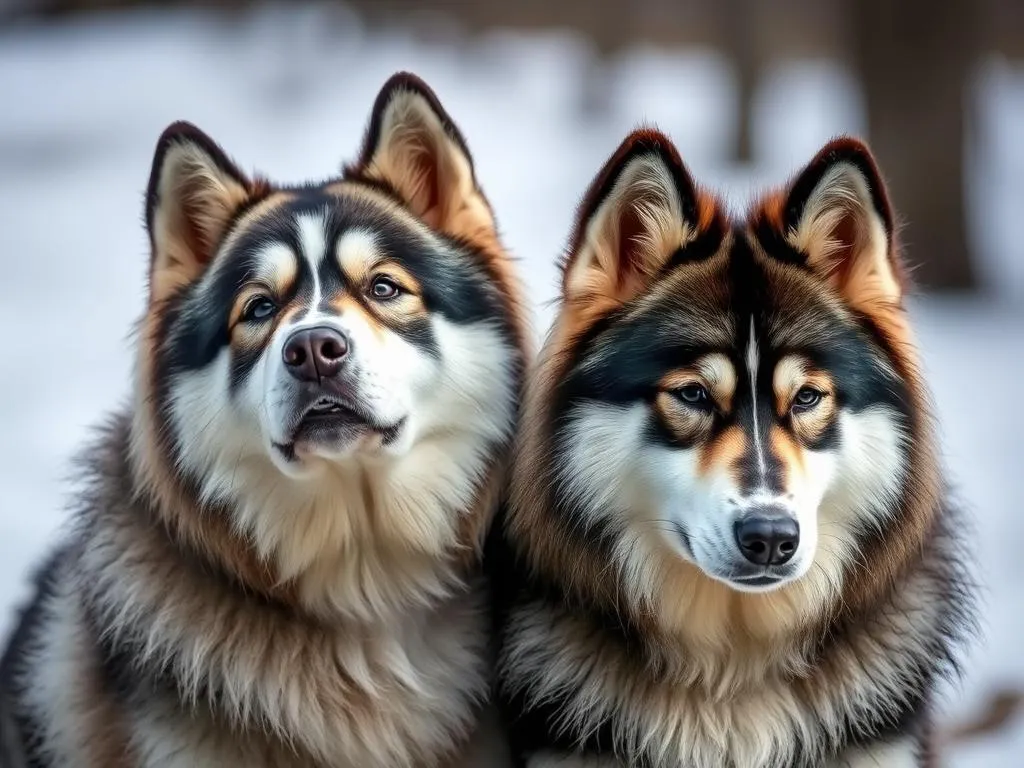
Introduction
The health and well-being of our canine companions are paramount to ensuring they lead happy, fulfilling lives. This is especially true for robust breeds like the Alaskan Malamute, known for their strength and endurance. Understanding the Alaskan Malamute lifespan and the unique health care needs of this breed is crucial for any prospective or current owner. With the right knowledge, owners can significantly enhance the quality of life for their beloved Malamutes.
Understanding the Alaskan Malamute
Breed Characteristics
The Alaskan Malamute is a large and powerful dog, originally bred for heavy hauling and sledding in harsh Arctic conditions. Adult males typically weigh between 95 to 105 pounds, while females range from 80 to 90 pounds. Their thick double coat, which can come in various shades, including gray, black, sable, and red, provides insulation against extreme temperatures.
In terms of temperament, Alaskan Malamutes are known for their friendly and affectionate nature. They are intelligent and social dogs, often forming strong bonds with their families. However, they can also display an independent streak, which may require consistent training and socialization.
Historical Background
The Alaskan Malamute has roots that trace back over 4,000 years to the Mahlemut people of Alaska, who bred these dogs for their strength and ability to work in packs. Initially, they were used for transportation and to assist in hunting. Today, while they may not be pulling sleds as often, they continue to be beloved companions and family pets.
Alaskan Malamute Lifespan
Average Lifespan
The typical Alaskan Malamute lifespan ranges between 10 to 14 years. This lifespan is relatively standard compared to other large breeds, but it is essential to note that individual health, genetics, and lifestyle can greatly influence longevity. Unlike smaller breeds that often live longer, Malamutes face some unique challenges that can affect their health as they age.
Factors Influencing Lifespan
Several factors can impact how long an Alaskan Malamute lives, including:
- Genetics and Hereditary Health Issues: Some Malamutes may be predisposed to certain genetic conditions, which can affect their overall health and lifespan.
- Environment: Living conditions, exposure to extreme weather, and the overall environment can play a significant role in their health.
- Nutrition and Diet: A balanced diet tailored to the needs of an Alaskan Malamute can prevent obesity and other health issues, ultimately impacting their lifespan.
- Exercise and Physical Activity: Regular exercise is vital for maintaining healthy weight and preventing various health conditions.
Common Health Issues in Alaskan Malamutes
Genetic Health Concerns
Being aware of common health issues can help mitigate potential problems. Some genetic health concerns for Alaskan Malamutes include:
- Hip Dysplasia: A common condition in larger breeds where the hip joint doesn’t fit snugly into the hip socket, causing pain and mobility issues.
- Elbow Dysplasia: Similar to hip dysplasia, this condition affects the elbow joint and can lead to arthritis if not managed properly.
- Eye Disorders: Alaskan Malamutes can be prone to various eye issues, including cataracts and progressive retinal atrophy, which can lead to vision loss.
Preventative Health Care
Preventative care is crucial for maintaining the health of your Alaskan Malamute. Regular veterinary check-ups can help catch potential health issues early. Owners should also ensure their pets are up-to-date on vaccinations and consider spaying or neutering to prevent certain health problems.
Nutrition and Diet
Nutritional Needs
A balanced diet is essential for the overall health of an Alaskan Malamute. High-quality dog food that meets the nutritional requirements of large breeds is recommended. Owners can choose from various diet types, including dry kibble, wet food, or raw diets, depending on their dog’s preferences and dietary needs.
Weight Management
Maintaining a healthy weight is crucial for the longevity of an Alaskan Malamute. Obesity can lead to serious health issues such as joint problems and diabetes. Here are some tips for managing your Malamute’s weight:
- Monitor food portions and avoid overfeeding.
- Incorporate regular exercise into their daily routine.
- Choose low-calorie treats and avoid table scraps.
Exercise Requirements
Daily Activity Levels
Alaskan Malamutes are energetic dogs that require substantial daily exercise. A minimum of 1 to 2 hours of physical activity is recommended, which can include walks, runs, or playtime in a secure area. Activities that engage their natural instincts, such as pulling or hiking, are particularly beneficial.
Mental Stimulation
In addition to physical exercise, mental stimulation is vital for Alaskan Malamutes. Boredom can lead to destructive behavior, so incorporating interactive toys, puzzle games, and training sessions can keep their minds sharp and engaged.
Grooming and Care
Coat Care
The thick double coat of an Alaskan Malamute requires regular grooming to keep it healthy and minimize shedding. Owners should brush their Malamute at least once a week, with more frequent grooming during seasonal shedding periods. This helps to remove loose fur and reduces the risk of matting.
Dental and Ear Care
Dental hygiene is often overlooked in dogs but is crucial for overall health. Regular brushing can prevent dental disease, which is common in large breeds. Additionally, checking and cleaning their ears weekly can prevent infections, especially since Malamutes have furry ears that can trap moisture and debris.
Signs of Aging in Alaskan Malamutes
Physical Changes
As Alaskan Malamutes age, they may exhibit physical changes such as decreased mobility and energy levels. Weight changes, whether gain or loss, can also indicate underlying health issues that require attention.
Behavioral Changes
Aging can also lead to behavioral changes in your Malamute. They might become less social or display signs of discomfort or pain. Being aware of these changes allows owners to provide the necessary care and adjustments to their routine.
End-of-Life Care
Recognizing End-of-Life Signs
As difficult as it may be, recognizing the signs that your Alaskan Malamute is nearing the end of its life is essential. Common signs include severe lethargy, loss of appetite, and difficulty standing or walking.
Palliative Care Options
If your Malamute is diagnosed with a terminal condition, palliative care options can help manage their pain and improve their quality of life. This may include medication, dietary adjustments, and providing a comfortable resting area.
Making the Decision
Deciding when to consider euthanasia is a deeply personal and emotional choice. Consulting with a veterinarian can provide guidance and support, ensuring that the decision is made with the best interests of the dog in mind. Emotional support for owners during this time is crucial, as the loss of a beloved pet can be devastating.
Conclusion
Understanding the Alaskan Malamute lifespan and their specific health care needs is vital for any owner. By being proactive in health management, addressing common health issues, ensuring proper nutrition, and providing ample exercise, owners can significantly enhance their Malamute’s quality of life. The joy of owning an Alaskan Malamute is immeasurable, making it essential to ensure they live long, healthy lives filled with love and adventure.









